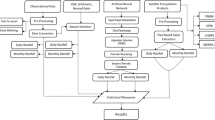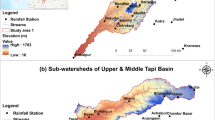Abstract
This study proposes a method, backpropagation (BP) neural network, for interpolating missing values in daily precipitation time series. Firstly, the BP neural network is adopted to interpolate missing daily rainfall data at three selected stations in Yantai, Shandong, China. Then, the temporal and spatial variations in precipitation extremes across Shandong are analyzed by utilizing the complete daily rainfall dataset derived from accurate propagation at 24 meteorological stations. The results show that the long-term trends in five selected extreme precipitation indices calculated from interpolated daily rainfall data are generally consistent with those from original nonmissing values. And the spatial patterns of trends in precipitation extremes also show better performance for BP neural network approach in interpolating missing daily rainfall gaps. Those suggest that this BP neural network algorithm can obtain a good fit in terms of space-time variability of regional precipitation extremes, in case that the correlation coefficients between the target stations with missing values and reference stations with complete daily rainfall dataset are relatively large. These findings could be crucial for investigating regional frequency of heavy rainfall and water resource management.









Similar content being viewed by others
References
Agarwal, A., & Singh, R. D. (2004). Runoff modelling through back propagation artificial neural network with variable rainfall-runoff data. Water Resources Management, 18, 285–300. https://doi.org/10.1023/B:WARM.0000043134.76163.b9.
Alexander, L. V., X. Zhang, T. C. Peterson, J. Caesar, B. Gleason, A. Klein Tank, M. Haylock, D. Collins, B. Trewin, and F. Rahimzadeh. Global observed changes in daily climate extremes of temperature and precipitation. Journal of Geophysical Research: Atmospheres 2006, 111(D5). doi: https://doi.org/10.1029/2005JD006290.
Alexander, L. V. (2016). Global observed long-term changes in temperature and precipitation extremes: a review of progress and limitations in IPCC assessments and beyond. Weather and Climate Extremes, 11, 4–16. https://doi.org/10.1016/j.wace.2015.10.007.
Bishop, C. M. (1995). Neural networks for pattern recognition (p. 504). Oxford: Clarendon.
Bennett, N. D., Newham, L., Croke, B., & Jakeman, A. J. (2007). Patching and disaccumulation of rainfall data for hydrological modelling. Int. Congress on Modelling and Simulation (MODSIM 2007). New Zealand: Modelling and Simulation Society of Australia and New Zealand Inc..
Becker, S., Hartmann, H., Coulibaly, M., Zhang, Q., & Jiang, T. (2008). Quasi periodicities of extreme precipitation events in the Yangtze River basin, China. Theoretical and Applied Climatology, 94, 139–152. https://doi.org/10.1007/s00704-007-0357-6.
Easterling, D. R., Meehl, G. A., Parmesan, C., Changnon, S. A., Karl, T. R., & Mearns, L. O. (2000). Climate extremes: observations, modeling, and impacts. Science, 289(5487), 2068–2074. https://doi.org/10.1126/science.289.5487.2068.
Elshorbagy, A. A., Panu, U. S., & Simonovic, S. P. (2000). Group-based estimation of missing hydrological data: I. Approach and general methodology. Hydrological Sciences Journal, 45(6), 849–866. https://doi.org/10.1080/02626660009492388.
Fausett, L. (1994). Fundamentals of neural networks. architectures, algorithms, and applications (p. 462). Upper Saddle River: Prentice-Hall.
Field, C. B. (2012). Managing the risks of extreme events and disasters to advance climate change adaptation: special report of the intergovernmental panel on climate change. Cambridge: Cambridge University Press.
Field, C. B., Barros, V. R., Dokken, D. J., Mach, K. J., Mastrandrea, M. D., Bilir, T. E., Chatterjee, M., Ebi, K. L., Estrada, Y. O., Genova, R. C., & IPCC. (2014). Climate change 2014: impacts, adaptation, and vulnerability. Part A: global and sectoral aspects. Contribution of Working Group II to the Fifth Assessment Report of the Intergovernmental Panel on Climate Change. Cambridge: Cambridge University Press.
Groisman, P. Y., Knight, R. W., Easterling, D. R., Karl, T. R., Hegerl, G. C., & Razuvaev, V. N. (2005). Trends in intense precipitation in the climate record. Journal of Climate, 18, 1326–1350. https://doi.org/10.1175/JCLI3339.1.
Günther, F., & Fritsch, S. (2010). neuralnet: training of neural networks. The R Journal, 2(1), 30–38. 10.11821/yj2010090018.
Gao, T., & Xie, L. (2014). Multivariate regression analysis and statistical modeling for summer extreme precipitation over the Yangtze River basin, China. Advances in Meteorology. https://doi.org/10.1155/2014/269059.
Gao, T., & Shi, X. (2016). Spatio-temporal characteristics of extreme precipitation events during 1951–2011 in Shandong, China and possible connection to the large scale atmospheric circulation. Stochastic Environmental Research and Risk Assessment, 30, 1421–1440. https://doi.org/10.1007/s00477-015-1149-7.
Gao, T., Xie, L., & Liu, B. (2016). Association of extreme precipitation over the Yangtze River Basin with global air-sea heat fluxes and moisture transport. International Journal of Climatology, 36, 3020–3038. https://doi.org/10.1002/joc.453.
Guo, J., Su, T., Li, Z., Miao, Y., Li, J., Liu, H., Xu, H., Cribb, M., & Zhai, P. (2017). Declining frequency of summertime local-scale precipitation over eastern China from 1970 to 2010 and its potential link to aerosols. Geophysical Research Letters, 44, 5700–5708.
Hecht-Nielsen, R. Theory of the backpropagation neural network. Neural networks, 1989. IJCNN, International Joint Conference on, IEEE. 1989.
Hasan, M. M. and B. Croke. Filling gaps in daily rainfall data: a statistical approach. 20th International Congress on Modeling and Simulation, Adelaide 2013.
IPCC. (2012). Summary for policymakers. In C. B. Field, V. Barros, T. F. Stocker, D. Qin, D. J. Dokken, K. L. Ebi, M. D. Mastrandrea, K. J. Mach, G.-K. Plattner, S. K. Allen, M. Tignor, & P. M. Midgley (Eds.), Managing the risks of extreme events and disasters to advance climate change adaptation. A special report of working groups I and II of the intergovernmental panel on climate change (pp. 3–21). Cambridge: Cambridge University Press.
Intergovernmental Panel on Climate Change (IPCC). (2013). Summary for policymakers. In T. F. Stocker, D. Qin, G.-K. Plattner, M. Tignor, S. K. Allen, J. Boschung, A. Nauels, Y. Xia, V. Bex, & P. M. Midgley (Eds.), Climate change 2013: the physical science basis. Contribution of working group I to the fifth assessment report of the intergovernmental panel on climate change. Cambridge: Cambridge University Press.
Intrator O. and Intrator N. (1993) Using neural nets for interpretation of nonlinear models. Proceedings of the Statistical Computing Section, 244–249. San Francisco: American Statistical Society (eds).
Jiang, D. J., Li, Z., & Wang, K. (2011). Trends of extreme precipitation events over Shandong Province from 1961 to 2008. Sci Geogr Sin/Dili Kexue, 31, 1118–1125. (in Chinese. 10.11821/yj2010090018.
Kraus, E. B. (1977). Subtropical droughts and cross-equatorial energy transports. Monthly Weather Review, 105, 1009–1018. https://doi.org/10.1175/1520-0493(1977)105<1009:SDACEE>2.0.CO;2.
Klein Tank, A., T. C. Peterson, D. A. Quadir, S. Dorji, X. Zou, H. Tang, K. Santhosh, U. R. Joshi, A. K. Jaswal and R. K. Kolli. Changes in daily temperature and precipitation extremes in central and south Asia. Journal of Geophysical Research: Atmospheres 1984–2012 2006, 111 doi: https://doi.org/10.1029/2005JD006316.
Landsea, C. W., & Gray, W. M. (1992). The strong association between Western Sahel monsoon rainfall and intense Atlantic hurricanes. Journal of Climate, 5, 435–453. https://doi.org/10.1175/1520-0442(1992)005<0435:TSABWS>2.0.CO;2.
Lucio, P. S., Conde, F. C., Cavalcanti, I., Serrano, A. I., Ramos, A. M., & Cardoso, A. O. (2007). Spatiotemporal monthly rainfall reconstruction via artificial neural network—case study: south of Brazil. Advances in Geosciences, 10, 67–76.
Liang, K., Liu, S., Bai, P., & Nie, R. (2015). The Yellow River basin becomes wetter or drier? The case as indicated by mean precipitation and extremes during 1961–2012. Theoretical and Applied Climatology, 119(3–4), 701–722. https://doi.org/10.1007/s00704-014-1138-7.
Meehl, G. A., Zwiers, F., Evans, J., Knutson, T., Mearns, L., & Whetton, P. (2000). Trends in extreme weather and climate events: issues related to modeling extremes in projections of future climate change. Bulletin of the American Meteorological Society, 81, 427–436.
Morales, J. A., Sanchez, L., Velasquez, H., De Borrego, B., De Nava, M., Portillo, D., Cano, Y., Morillo, A., Albornoz, A., & Socorro, E. (2001). Nutrient loading by precipitation in the Maracaibo Lake basin, Venezuela. Water, Air, and Soil Pollution, 130, 511–516.
Malek, M. A., Harun, S., Shamsuddin, S. M., & Mohamad, I. (2009). Reconstruction of missing daily rainfall data using unsupervised artificial neural network. International Journal of Computer Systems Science and Engineering, 4(2), 79–84.
Nilles, M. A., & Conley, B. E. (2001). Changes in the chemistry of precipitation in the United States, 1981–1998. Water, Air, and Soil Pollution, 130, 409–414.
Patel, K. S., Shukla, A., Tripathi, A. N., & Hoffmann, P. (2001). Heavy metal concentrations of precipitation in east Madhya Pradesh of India. Water, Air, and Soil Pollution, 130, 463–468.
Presti, R. L., Barca, E., & Passarella, G. (2010). A methodology for treating missing data applied to daily rainfall data in the Candelaro River Basin (Italy). Environmental Monitoring and Assessment, 160(1–4), 1–22. https://doi.org/10.1007/s10661-008-0653-3.
Powell, E. J., & Keim, B. D. (2015). Trends in daily temperature and precipitation extremes for the southeastern United States: 1948–2012. Journal of Climate, 28, 1592–1612. https://doi.org/10.1175/JCLI-D-14-00410.1.
Rumelhart, D. E., Hinton, G. E., & Williams, R. J. (1986). Learning representations by back-propagating errors. Nature, 323, 533–536.
Rudden, M. (1998). Principles of geographical information systems. Journal of Environmental Planning and Management, 41(6), 777–784. https://doi.org/10.1080/09640569811425.
Rosenfeld, D., Dai, J., Yu, X., Yao, Z., Xu, X., Yang, X., & Du, C. (2007). Inverse relations between amounts of air pollution and orographic precipitation. Science, 315, 1396–1398.
Simolo, C., Brunetti, M., Maugeri, M., & Nanni, T. (2010). Improving estimation of missing values in daily precipitation series by a probability density function-preserving approach. International Journal of Climatology, 30(10), 1564–1576. https://doi.org/10.1002/joc.1992.
Tian, L., Wang, L., Yu, H., & Yang, R. (2012). Interpolation of missing precipitation data base on BP neural network. Journal of Yunnan Agricultural University, 27(2), 281–284 (in Chinese).
Wei, T. C. and J. L. McGuinness. Reciprocal distance squared method, a computer technique for estimating areal precipitation. Washington: ARS-NC. 1973.
Wu, J., Gao, X., Giorgi, F., & Chen, D. (2017). Changes of effective temperature and cold/hot days in late decades over China based on a high resolution gridded observation dataset. International Journal of Climatology. https://doi.org/10.1002/joc.5038.
Zhang, Q., Xu, C., Zhang, Z., Chen, Y. D., Liu, C., & Lin, H. (2008). Spatial and temporal variability of precipitation maxima during 1960–2005 in the Yangtze River basin and possible association with large-scale circulation. Journal of Hydrology, 353(3), 215–227. https://doi.org/10.1016/j.jhydrol.2007.11.023.
Zhang, X., Alexander, L., Hegerl, G. C., Jones, P., Tank, A. K., Peterson, T. C., Trewin, B., & Zwiers, F. W. (2011). Indices for monitoring changes in extremes based on daily temperature and precipitation data. Wiley Interdisciplinary Reviews:Climate Change, 2(6), 851–870. https://doi.org/10.1002/wcc.147.
Zwiers, F. W., Alexander, L. V., Hegerl, G. C., Kossin, J. P., Knutson, T. R., Naveau, P., Nicholls, N., Schär, C., Seneviratne, S. I., Zhang, X., Donat, M., Krueger, O., Morak, S., Murdock, J. W., Schnorbus, M., Ryabin, V., Tebaldi, C., & Wang, X. L. (2013). Challenges in estimating and understanding recent changes in the frequency and intensity of extreme climate and weather events. In G. R. Asrar & J. W. Hurrell (Eds.), Climate science for serving society: research modelling and prediction priorities (pp. 339–389). Dordrecht: Springer 978-94-007-6691-4.
Zhuo, H., Zhao, P., & Zhou, T. (2014). Diurnal cycle of summer rainfall in Shandong of eastern China. International Journal of Climatology, 34, 742–750. https://doi.org/10.1002/joc.3718.
Acknowledgments
We gratefully acknowledge our editor, Prof. William Andrew Jackson, and two anonymous reviewers, for their professional suggestions and comments, which are greatly helpful for improving the quality of this manuscript.
Funding
This study is jointly supported by the Natural Science Foundation and Sci-Tech Development Project of Shandong Province (No. ZR2015DQ004; J15LH10), Project funded by China Postdoctoral Science Foundation (No. 2017T100103; 1191005830), National Natural Science Foundation of China (No. 41210008; 41406029), the United States National Oceanic and Atmospheric Administration Climate Change Program via a subcontract (No. uF-eieS-1100031-NCS) from University of Florida, and Young Academic Backbone in Heze University (No. XY14BS05).
Author information
Authors and Affiliations
Contributions
TG wrote the main manuscript text. HW designed and performed the experiments and also prepared the tables and figures. All authors reviewed the manuscript.
Corresponding author
Ethics declarations
Competing Interests
The authors declare that they have no competing interests.
Rights and permissions
About this article
Cite this article
Gao, T., Wang, H. Testing Backpropagation Neural Network Approach in Interpolating Missing Daily Precipitation. Water Air Soil Pollut 228, 404 (2017). https://doi.org/10.1007/s11270-017-3584-1
Received:
Accepted:
Published:
DOI: https://doi.org/10.1007/s11270-017-3584-1




